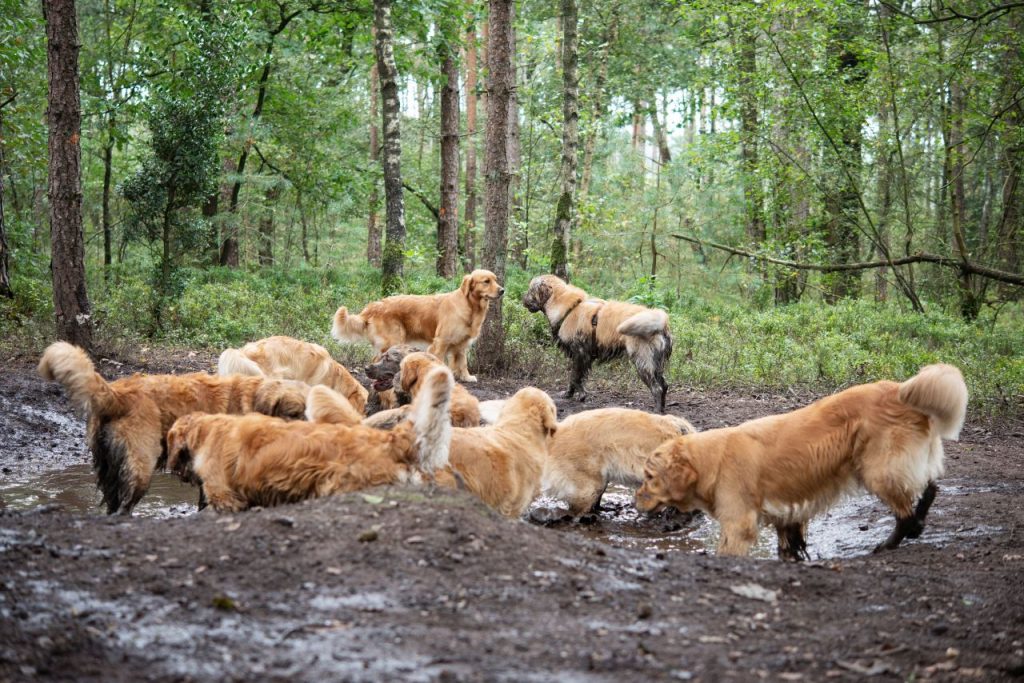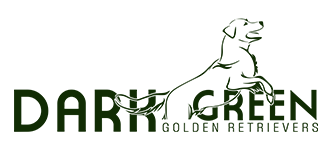
History:
The history of the Golden Retriever can be found on the breed association’s website (GRCN). In 1835, Lord Tweedmouth recorded the details of the dogs that contributed to the creation of the Golden Retriever. The Golden Retriever is one of the six retrievers bred specifically for retrieving shot game. The first Golden Retrievers came to the Netherlands in 1932, where they have since become one of the most popular breeds.
Breed Standard:
The breed standard can be found here.
Character:
What makes Retrievers special is their love for water and natural retrieving ability. The original purpose for which Retrievers were bred is still evident in today’s dogs, making them well-suited for hunting (gundog training) or tracking. Retrievers had to work well with their handler in the field, making them excellent family dogs who enjoy activities with their owner. They are known as very social, gentle dogs, who are intelligent and not easily startled. The working drive in Goldens generally makes them best suited for an active family that can meet both their physical and mental needs. Five short walks a day are not enough for these dogs. They often love children, but it’s crucial that both children learn how to interact with dogs and vice versa. The book “Billy, onze vriend” is a great book to read with children to build a good relationship between dog and child.
This breed has working lines, show lines, and dual-purpose bred dogs. Dogs from the working lines are very suitable for working with a handler and need significant mental challenges. As a family dog without additional challenges, they do not thrive. Dogs from the show lines are active but generally need slightly fewer mental challenges. Dual-purpose Goldens are suitable for both work and show and need mental challenges but are also very suitable as family dogs.
Health:
Every breed can have hereditary disorders. If you want to breed a Golden Retriever through the breed association (GRCN), the parent dogs must be tested for: HD and ED, the eyes must be examined and have a valid result at the time of mating. The eye result is valid for one year. Additionally, a DNA test for PRA1, PRA2, and Ichthyosis must be performed. Other disorders may also occur that are not (cannot be) tested for. You can read more about common hereditary disorders here.
Activities:
Golden Retrievers are intelligent and active dogs that need both physical exercise and mental challenges to be happy.
Walking:
Puppies should only take very short walks. Each week they can walk a minute longer. So, if the puppy is 10 weeks old, he can walk for 10 minutes a day. This is very short, so carry your puppy to the spot where he can walk. For longer distances, a Doggyride can be handy (take time to get the puppy used to it first). Quiet walks are a good activity for puppies and young dogs, let them sniff and explore. Puppies tend to stay close to you, so they can walk off-leash in safe areas or on a long leash of at least 3 meters, but 5 or 10 meter leashes can also be very useful (absolutely no flexi leashes and always attach a long leash to a harness, not a collar, to prevent damage to the dog’s body). A y-harness and a leash of at least 3 meters work best for puppies and young dogs. This gives them enough space to explore the world safely and teaches them that pulling on the leash is unnecessary to get somewhere. Ensure the leash is always slack, especially for puppies. Discovering the world is enough for the first few weeks, but you can start practicing recall and walking without pulling. After a few weeks, you can incorporate fun activities into the walk. Smear something tasty on a tree and let the puppy/young dog lick it off. Scatter treats in the tall grass and let him find them. If the dog loves a toy, hide it during the walk and let him find it. Engaging with your dog during walks is very beneficial. Adult Goldens love long walks (daily between 1 to 2 hours approximately) and also need off-leash time and regular swimming alongside their potty breaks. Generally, five walks a day are sufficient for adult dogs, but puppies need to go outside more often to relieve themselves (about every 2 hours, especially after sleeping, playing, eating, etc.).
Social walks are great for dogs to improve their social skills and boost their confidence. These are walks with socially skilled dogs (on leash). This can be hard to organize yourself, but fortunately, more dog schools are offering such walks. Puppies jumping on each other or adult dogs being too rough with puppies should be avoided to ensure positive experiences. Male dogs in puberty have increased testosterone levels, which can sometimes lead to negative interactions with other males. Plan pleasant encounters with stable dogs and try to avoid unpredictable interactions during this period.
Balance and Coordination:
Moving your body with confidence and body awareness requires coordination, strength, balance, and flexibility. This forms the basis of Balance and Coordination training. These skills are not just physical but also mental. The exercises or challenges have a significant impact on the dog’s mental state. Think about how you feel when facing a physical challenge; the mental aspect plays a role in whether you succeed immediately or not. By facing challenges and becoming more familiar with their bodies, dogs experience increased confidence. The exercises promote body awareness. For more information, see Sam Turner.
Gundog Training:
Using a dog’s natural talents is perhaps the most rewarding activity. Besides it being fun to be in nature together and meeting the dog’s physical and mental needs, it is also a huge boost for the dog’s confidence and overall well-being. Gundog training teaches the dog (and the handler) to perform work after the shot. This training includes retrieving, obedience, swimming, searching, walking on a leash, recall, and staying in place, usually with dummies but also with game. For Retrievers, it is a wonderful way to work together. Note that if you practice this enjoyable sport at a dog school, the training must be given exclusively positively and without punishment.
Retrieving Sport:
This sport is similar to gundog training but without game.
Nose work:
Tracking, mantrailing, detection, rescue work, etc., are all activities where the dog uses his nose. Using their nose is a great mental challenge for all dogs and perfectly suited to them. Dogs can smell much better than humans, perhaps 10,000 times better. They live in a world full of scents, so using this talent is very enjoyable. The advantage of a mental challenge using the nose is that the dog won’t become hyper or stressed but will be tired and satisfied after the work. These are very suitable activities, whether practiced at a dog school or done on your own.
Other Activities:
Obedience, agility, hoopers, canicross, flyball, dog dancing, dog frisbee, etc., can also be practiced by the versatile Golden, but make sure it suits your dog. Pay attention to stress levels and physical strain, especially for dogs under 2 years old.
Note:
In warm or very cold weather or snow, it’s important to be mindful of activities. Dogs cannot handle heat well. They cannot sweat and can only lose heat through panting and their paw pads. Cars heat up quickly, so never leave a dog alone in a car (even if it’s not extremely hot). Activities can also be too much in warm weather. If it’s hot (above 23 degrees Celsius), walk your dog early and avoid hot asphalt. Seek shade and take it easy. A cooling mat or a wet towel on the ground can provide some relief. Swimming is also nice, but mostly paddling without getting the back wet. Intense swimming can also cause dogs to overheat, and a wet back can become uncomfortable in the heat. If the dog’s back gets wet, dry it thoroughly.
Relaxation:
Activities are fantastic and necessary for Golden Retrievers, but relaxation and rest are just as important. Plan a day with no cues (commands) for the dog unless safety is at risk. Give your dog a massage if they enjoy it, regularly offer something to chew or lick for relaxation, and even digging can be relaxing, so a good digging spot nearby would be ideal.

